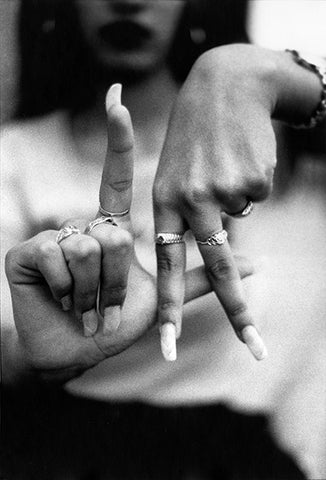ESTEVAN ORIOL
L.A. Fingers
Written by Caroline Ryder

In 1995, Chicano street photographer Estevan Oriol held a now-famous photo session in which he asked a Latina model with a fierce set of claws to arrange her bling-gilded fingers in the shape of two letters: L and A.
Her black, pillowy lips pouting in the background, the image presented a mesmerizing, defiant symbol of West Coast pride, steeped in lowrider culture, baggy pants, mamacitas with pencil-thin brows, homies smoking the chronic and mi vida loca, signaled in three dots tattooed under a gangbanger’s eye.
It reclaimed the typography of the Hollywood sign, whitewashed and serene above the Hollywood Hills homes of the rich, and reworked it for the gardeners, maids and miscellaneous Latino laborers upon whose shoulders the city still rests.
It reimagined the Dodgers’ interlocking L.A. symbol, the lower bar of the L acting as the crossbar of the A since the late 1950s, back when construction of Dodger Stadium in Chavez Ravine bulldozed Mexican ranches and decades of Chicano heritage with them.
Not since the palm tree, the smoggy freeway or the lonely Hockney swimming pool had one image so succinctly captured the essence of Los Angeles — the brown Los Angeles of the latter 20th century, inaccessible and forbidden until Oriol (with its full blessing) delivered it to us.
Oriol was a young Hollywood club bouncer with a Polaroid camera in his jacket when he started taking photos, his images of the Red Hot Chili Peppers and Cypress Hill picked up by music magazines of the era. His father, photographer Eriberto Oriol, noticed his son’s innate eye for character and, shortly before Estevan went on the road with rap acts House of Pain and Cypress Hill, he handed his son an SLR and urged him to continue documenting his experiences.
In between tours, he took his treasured lowrider to meets filled with other young Mexican- and African-American car owners, back when driving such a gaudy vehicle made you a target for cops. Usually he’d be the only guy with a camera. “You couldn’t just stroll in and ask to take a picture,” he says. “You had to know somebody, and you had to present yourself a certain way. You had to show respect and be respected in order to gain access.” Soon enough a lowrider magazine in Japan, where passions for car customization run high, commissioned him to shoot the scene and broader culture on a regular basis, launching his career.
For more than 20 years, Oriol painted L.A. Chicano culture largely in the black, white and gray tones of early Hollywood noir, swapping the red carpet for asphalt, Oscar gowns for booty shorts and cocktail parties for backyard BBQs in East L.A. It wasn’t long before today’s Hollywood celebrities came calling, wanting Oriol to train his lens back on them. The world had woken up to Chicano culture, and thanks in large part to Oriol, they wanted more.
He’s shown his work in major museums, traveled the world as a freelance photographer and photographed stars for top-selling publications — but the pull to document real life in his surreal home city remains. Every day he’s reminded of the changes. Acute homelessness mixed with $10 juices and expensive lofts. Gangsters who post photos to Instagram from their prison cells. More cameras than cars at lowrider meets. Meanwhile, the L.A. Fingers photograph endures, absorbed into the local iconography, the simplest, most powerful photo Oriol ever shot. It no longer belongs to him. It belongs to the city.
 Images shown (from top to bottom):
Images shown (from top to bottom):L.A. fingers, 1995. Photo by Estevan Oriol
Los Angeles photos by Estevan Oriol
